How to summarize a period of 5 years of untold suffering with more than 60 million victims in a limited number of lines?
When Hitler was ready to fight in 1938, everything went smoothly in the beginning. Despite the provisions of the Treaty of Versailles at the end of the First World War, the Allies allowed the situation in Germany to get completely out of hand. The construction of a large and strong army in Germany could be carried out without too much opposition. Austria was the first to merge silently with Germany in 1938 and in September 1939 Hitler thought the time was right to invade Poland with an excuse. In April 1940, Denmark was conquered in one day and in June 1940 Norway followed, although both countries had been neutral, after resistance of a few months (Operation Weserübung). At the same time, in May 1940 under the leadership of Erich von Manstein, Heinz Guderian and Erwin Rommel de Blitzkrieg (Fall Gelb) was started and in a short period of time the Netherlands, Belgium, Luxembourg and France were overrun.
So much for a great success story for Hitler. The Axis countries that participated with Hitler were, in addition to Japan, Italy, Hungary (1940), Romania (1940), Bulgaria (1941), Slovakia (1940) and Croatia (1941). Franco in Spain had already come to power through the help of the Germans and was therefore friends with Hitler, although the official reading was that Spain was neutral.
The aim of the Axis countries was territorial expansion, changing the international order, spreading fascism and militarism and defending against communism.
The first setback for Hitler was losing the battle in the air against England in July 1940. Hitler would also overrun England very quickly, but that was in reality quite disappointing (Operation Seelöwe). Eventually Hitler refrained from further attempts, but the attack had come at the expense of a loss of most of his aircraft and pilots. The lack of sufficient impact in the air proved to be decisive in the course of the war.
In a mood of total self-overestimation, Hitler pretended in July 1941 that the Molotov-Von Ribbentrop concluded with Russia did not exist and gave the go-ahead to operation Barbarossa, with the aim of completely defeating the Russians.
In December 1941, the Japanese army decided to attack the American island of Pearl Harbor. This attack drew the giant America into the fight and that would also have major consequences for Hitler in Europe. U.S. industry began to run at full speed and the production of war equipment was soon on track.
So there were already a number of serious dark clouds on the firmament for Hitler, but because of his fanaticism he refused to see this.

Barbarossa became, after a glorious start as a continuation to the Blitzkrieg, a huge defeat for Hitler when the Russians managed to rebuild their military strength and hit back very hard. The freezing and wet winter and the failure of logistics, ensured that Friedrich Paulus’s 6th army at Stalingrad was finally defeated. The Russians were now ready to steam up to Berlin (operation Bagration).
Italy had since defected to the Allies in September 1943. In July 1943, the Americans and the English landed in Sicily and then went to Italy’s mainland to drive the Germans back.
At the same time as operation Bagration, Stalin requested the opening of a second front which led to the invasion of Normandy in June 1944 and a landing in southern France in August 1944.

All these events ultimately meant the end of the Third Reich and also the end of the Great Asian Empire. The bombing of Hiroshima and Nagasaki and the end of the non-aggression treaty with the Russians and the attack by the Russians on Mongolia made the Japanese decide to give up the fight. Japan surrendered in August 1945.
So the aggressors were defeated, but Winston Churchill summed everything up well at the end of the bloodshed in his “Iron Curtain Speech”:
“From Stettin in the Baltic to Trieste in the Adriatic, an iron curtain has descended across the continent. It is certainly not the Liberated Europe we fought to build up, nor is it one which contains the essentials of permanent peace.” The speech marked the beginning of the Cold War.
VE-Day, 8 and 9 May 1945
Germany’s final defeat led to great joy scenes in almost all Allied countries to celebrate victory. Truman and Churchill have announced this day as VE-Day, although the war against Japan continued until August 1945.
The official capitulation of the Germans initially took place in Reims on May 7, 1945. Chief of Staff Alfred Jodl signed the “Instrument of Surrender” at the Allied headquarters, the Supreme Headquarters of Allied Expeditionary Forces (SHAEF) in Reims.
The Soviets did not find the rank of Jodl high enough. That is why Field Marshal Wilhelm Keitel, as a representative of the Oberkommando der Wehrmacht, was called up a day later in Berlin, together with General Stumpf on behalf of the Luftwaffe, Admiral Von Friedeburg on behalf of the Kriegsmarine to re-sign the capitulation. However, the Russians had forgotten a few sentences in the document and eventually Keitel signed the papers in the early morning of May 9. The Americans have protocol problems with the signing, Eisenhower decides not to go and sends his deputy Arthur Tedder. Zhukov is in charge of the signing.
For the Americans and the British, VE-Day is on May 8, for the Russians on May 9, 1945.
The German total military defeat is important. The Allies do not want to give the Germans an excuse that the German army has been stabbing in the back, as happened at the end of the First World War, when German soldiers signed the Treaty of Versailles with a lower rank.
The Allies also believe that there is a political defeat. No Nazis in the German government. In doing so, the Flensburg government of Reichspräsident Dönitz, Hitler’s successor, is faltering and Dönitz is giving a speech in which he announced the end of the Nazi regime. The power in Germany now lies with the occupying force.
Winston Churchil:
“God bless you all. This is your victory. In our long history, we have never seen a greater day than this. Everyone, man, or woman, has done their best”.
The Neurenberg trials
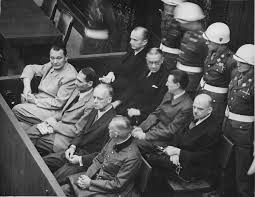
The number of criminal charges relating to the Nazis rose to 36,000. But strangely, there was anti-Semitism in every country, especially in America, where many anti-Semites were in government. The well-known far-right senator Joe McCarthy was a strong supporter of the cancelation of the war crimes and the U.S. State Department forced England to reduce or cancel the punishment of Nazis, under the motto “bury the past and move on.”
The Nuremberg trials were held in the city of Nuremberg to adjudicate 24 headpieces of the Nazi regime, suspected of committing serious crimes before and during World War II. The defendants were senior officers, industrialists, lawyers and doctors.
The tribunal was established by the United States, the Soviet Union, the United Kingdom and France. The court was given the name of the International Military Tribunal, as the starting point of the current International Criminal Court.
The Nuremberg Trials are best known, but not the only trials that were held in Nuremberg. There were also other trials, but before American military courts.
The trial began on November 20, 1945 and lasted until October 1, 1946. The defendants stood trial for conspiracy, crimes against peace, crimes against humanity and war crimes.
Main members of the Nazi regime that could not be convicted:
Adolf Hitler – committed suicide on April 30, 1945
Heinrich Himmler – committed suicide on May 23, 1945
Joseph Goebbels – committed suicide on 1 May 1945
Defendants and the verdict:
Rudolf Hess – life sentence (committed suicide on 17/8/1987 after a number of previous attempts)
Hermann Göring – death penalty
Karl Dönitz – 10 years
Albert Speer – 20 years
Martin Bormann – death penalty (in the absence, probably committed suicide in early May 1945)
Then the layer directly below the main members:
Joachim von Ribbentrop, Reich Minister of Foreign Affairs – death penalty
Wilhelm Keitel, Reich Minister of War – death penalty
Erich Räder, Grand Admiral, life sentence
Alfred Jodl, Chief of Operations Wehrmacht – death penalty
Wilhelm Frick, Reichs Minister – death penalty
Konstantin von Neurath, Reichs Minister – 10 years
Arthur Seyss-Inquart, Reichs Minister – death penalty
Halmar Schacht, President of the National Bank – Acquittal
Hans Frank, Reichs Minister – death penalty
Alfred Rosenberg, Reichs Minister – death penalty
Fritz Sauckel and Julius Streicher – death penalty
Baldur von Schirach, Reichs Minister and leader Hitlerjugend – 20 years
Franz von Papen, Vice Chancellor – acquittal
Walther Funk, Reichs Minister – life sentence
Ernst Kaltenbrunner, successor Reinhard Heydrich, Reichssicherheitshauptamt – death penalty
Hans Fritzsche, Secretary-General Ministry of Information and Propaganda – Acquittal
ODESSA and the Rat Line
ODESSA – Organisation of the former SS-Angehörigen, was a supposed network of SS officers and sympathizers, with as leader Otto Skorzeny and with the aim of helping high Nazis flee after the German surrender.
There are various opinions about the actual existence of ODESSA, but what is absolutely certain is that there were one or more organizations that helped German war criminals and collaborators from other countries to flee Germany and avoid their possible criminal prosecution. Many have migrated to Spain, the Middle East and Latin America. A well-known route was the Rat Line, which ran from Germany via Austria, South Tyrol and by sea to the destination. There are huge numbers of fleeing Nazis involved. The Austrian bishop Alois Hudal played an important role in this. There are strong indications that the Vatican was involved in the escape routes. During the escape, monasteries offered shelter to the Nazi refugees. The Red Cross also played a role. Argentina in particular would have been helpful in providing thousands of blank passports. Europe was now finished with fascism, but in South America totalitarian regimes were on the rise and they received the fled Nazis with open arms. They could use the expertise in oppression. More than 10,000 former military personnel would eventually have found their way to South America.
Alois Hudal
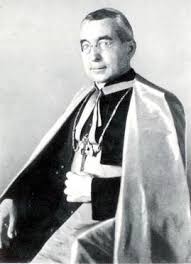
Alois Hudal (31/05/1885 – 13/5/1963) was an Austrian bishop. He considered the Nuremberg trials to be the “victor’s justice” of the Allies. Hudal saw in the Hitler regime an active force against advancing communism. The education of youth would be left to the Church, while the German Nazi government would be supported by the Church in its political and military decisions. In 1947, Hudal was put on non active and his diplomatic Vatican passport was taken away. He defended his help to Nazi and other German leaders at the end of the war until his death.
Famous Nazi leaders who used the Rat Line:
Josef Mengele
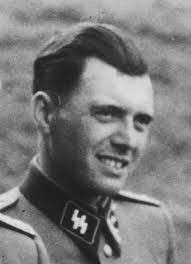
Josef Mengele (16/3/1911 – 7/2/1979) was one of the best-known Nazi members who managed to escape to South America. From May 1943 he worked in Auschwitz as a doctor and was responsible for the selection of the prisoners. He became notorious for his brutal medical experiments on prisoners, particularly on twins.
After the war, Mengele remained under the radar and worked under a false name as a farmhand in a village near Rosenheim. In 1949, he escaped through the Rat Line to South America. He lived in Buenos Aires for 10 years. In 1957, Mengele, who worked as a doctor in illegal abortion clinics, was arrested by the police with the charge “committing a hundredfold abortion and the dead of a young woman during an abortion”. Mengele moved to Paraguay and became a citizen there. The Mossad tracked him down, but when the Mossad invaded the hotel, Mengele, after a tip, fled. He went into hiding in Brazil. Mengele died in 1979 while swimming from a heart attack or stroke.
Adolf Eichmann
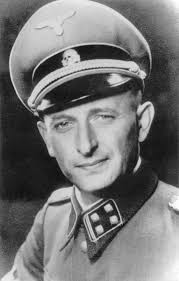
Adolf Eichmann (19/3/1906 – 1/6/1962) was the right-hand man of Heinrich Himmler and Reinhard Heydrich and was the chief responsible for the mass murder of the Jews. He arranged the transports to the death camps, visited Belzec and Auschwitz several times as a close friend of camp boss Rudolf Höss and arranged the preparations for the Wansee Conference. After the occupation of Hungary, Eichmann left with 150 men to Budapest. Due to his “organizational talent” 437,000 Hungarian Jews were transported to the extermination camps. This continued until he had to flee from the advancing Red Army on December 23, 1944. A total of 565,000 Hungarian Jews were killed (Aktion Höss).
After the war he was captured by the Americans, but managed to escape and worked for a time as Otto Heninger as a forest worker on the Lüneburger Heide. On June 1, 1950, he was able to escape to Argentina via the Red Cross. He was kidnapped by the Mossad and the Shin Beth in a spectacular way from Argentina to Israel on 11 May 1960. On December 15, 1961, after a trial against him in Israel, he was sentenced to death and hanged on June 1, 1962.
Klaus Barbie
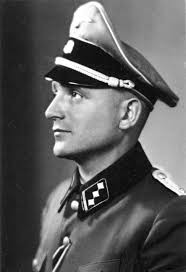
Barbie (25/10/1913 – 25/9/1991) was head of the Gestapo in Lyon and responsible for the murder of 4000 Jews and resistance fighters and the deportation of 7500 Jews to Auschwitz. One of his most notorious crimes was the deportation and murder of 44 Jewish children from a home in Izieu in southern France.
Barbie initially hid in Germany until he was discovered by the American Counterintelligence Service (CIC). Instead of arresting Barbie, the CIC (forerunner CIA) hired him as an informant about Soviet activities in West Germany. When France urged Barbie’s extradition to France, the Americans helped him escape to Bolivia.
In 1972, French Nazi hunters tracked down Barbie, but Bolivia refused to extradite him. It was not until 1972, under another government in Bolivia that Barbie was extradited to France and was sentenced to life in prison.
Franz Stangl
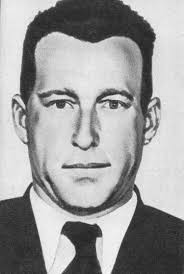
Franz Stangl (26/3/1908 – 28/6/1971), commander of several extermination camps in Poland, clearly enjoyed his work. He worked in Sobibor, together with Franz Reichleitner, resulting in 250,000 casualties, in Treblinka, together with Irmfried Eberl, 870,000 victims and in Belzec, along with Christian Wirth, Gottlieb Hering and Rudolf Höss, 600,000 victims. After the war, Stangl was captured by the Americans. However, he escaped to Italy and from there he traveled in 1951 with a false pass from the Red Cross and with the help of Alois Hudal to Brazil. Stangl worked there until 1967 in a Volkswagen factory until Simon Wiesenthal tracked him down in 1967. When he was on trial in Germany, he felt that he had only done his duty. The judges sentenced Stangl to life in prison for mass murder. After an imprisonment of 6 months, Stangl died of a heart attack.
Josef Schwammberger
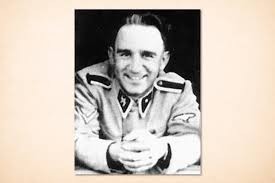
Josef Schwammberger (4/12/1912 – 3/12/2004) was a camp commander in the labor camps around Krakow in Poland. His dog was trained to attack people. He threw prisoners alive in the fire, beated babies with their heads against the wall because he didn’t want to spend bullets on it. He was arrested by the Allies in 1945, but managed to escape to Argentina in 1948. He was one of the ten most wanted Nazis in West Germany. West Germany demanded his extradition in 1973, but it was not until May 1990 that he was transferred to Germany. The charge of murdering 3377 prisoners could not be proven, but he was still found guilty of 7 murders and 32 times accessory in murder. He got life sentence.
Source:
Isgeschiedenis.nl
Historianet.nl
Various Wikipedia articles